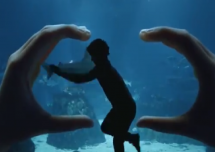About
Framing and sequencing: The grammar of visual media 
OVERVIEW
Young children can understand the process of media construction, and it helps them make sense of print and nonprint media both in and out of the classroom. In this activity, you will learn how to introduce children to the basic building blocks of visual media: the frame and the shot.
Children as young as five years old can begin to explore how visual media is constructed, even as they begin to learn about letters, words and sentences which are the building blocks of language and print media. Particularly for children who struggle with print literacy, learning about codes and conventions in nonprint media like videos, audio, and interactive web content can support their understanding of how messages are created.
ACTIVITY: The Visual Grammar of Framing and Sequencing
1. Start with Experience. Watch children talk about video camera and framing by viewing Framing with the Camera. Film is composed of a series of shots that are assembled together through editing. To understand this concept, watch Le Jour de Chien and see if you can clap each time the shot changes.
Frame: What’s included in a photograph. Make a rectangle with your fingers by making two Ls with your hands and connecting your thumbs on one hand to your index fingers on the other. Now look through the rectangle you’ve created—that’s your frame.
Shot: What is recorded between the time you start recording a video and the time you “cut,” or stop recording. Shots are edited together to make movies.
2. Explore Examples to Consider Adaptation to Learners and Contexts. Watch a group of young children Clapping to Spot the Shot. Pay attention to what children do when learning to spot the shot.
3. Compose, Create and Take Action. Watch the work of young children who created a short video, What Did the Dog Do? In this video, students assemble a sequence of images to explore how the sequence of images changes the story.
GUIDING QUESTIONS FOR REFLECTION:
- What are some of the similarities and differences between how film is structured and how print media is structured?
- What competencies are activated as children to learn about framing and sequencing?
- What inferences can you make about this teacher's motivations to create a "how to walk your dog" video? Why did she think it was a valuable use of class time?
- What kind of planning processes are likely to be involved in creating a "how to" video? What are your expectations about how children will respond to the challenge of communicating, problem-solving and collaboration that are necessary to create this type of media?




